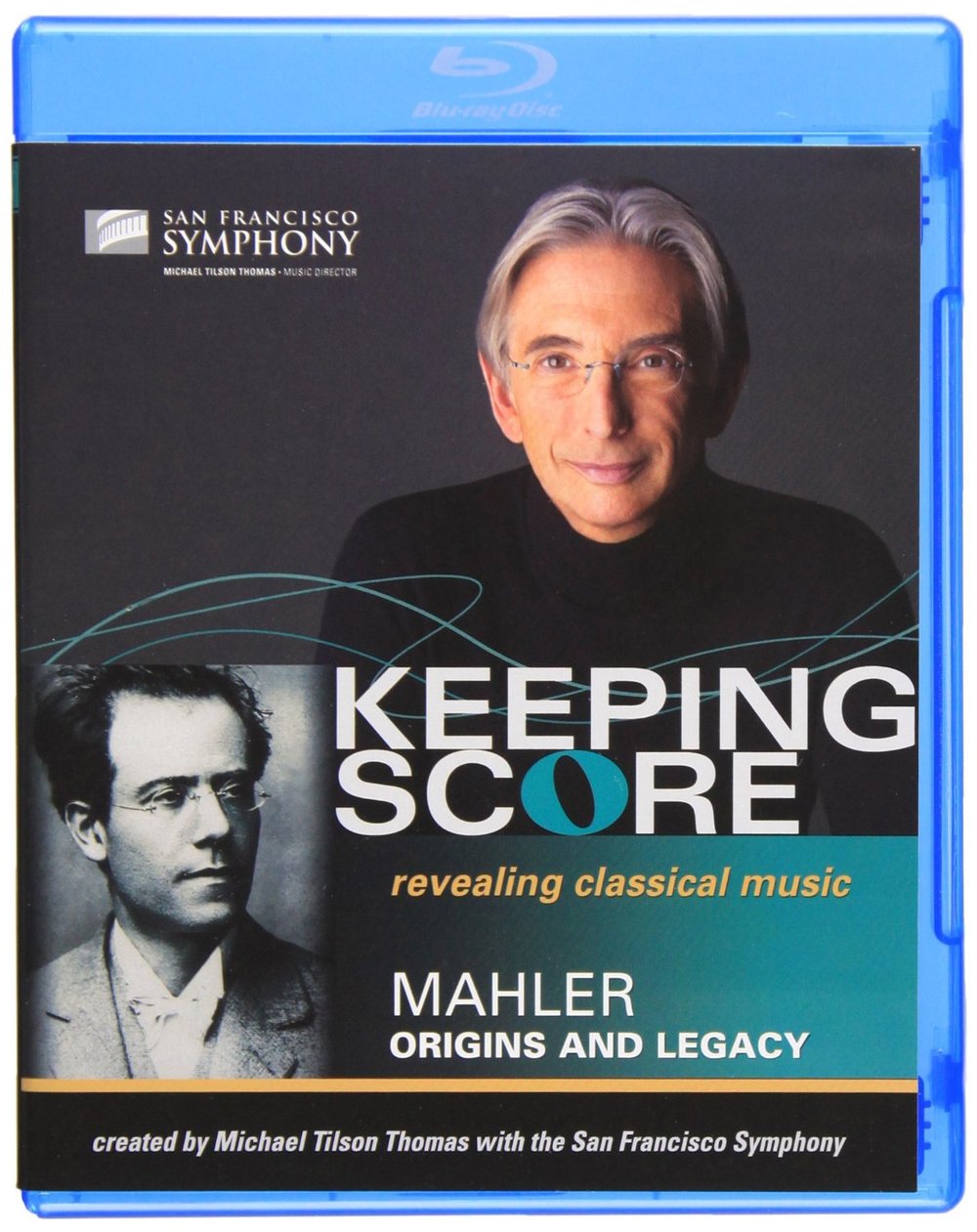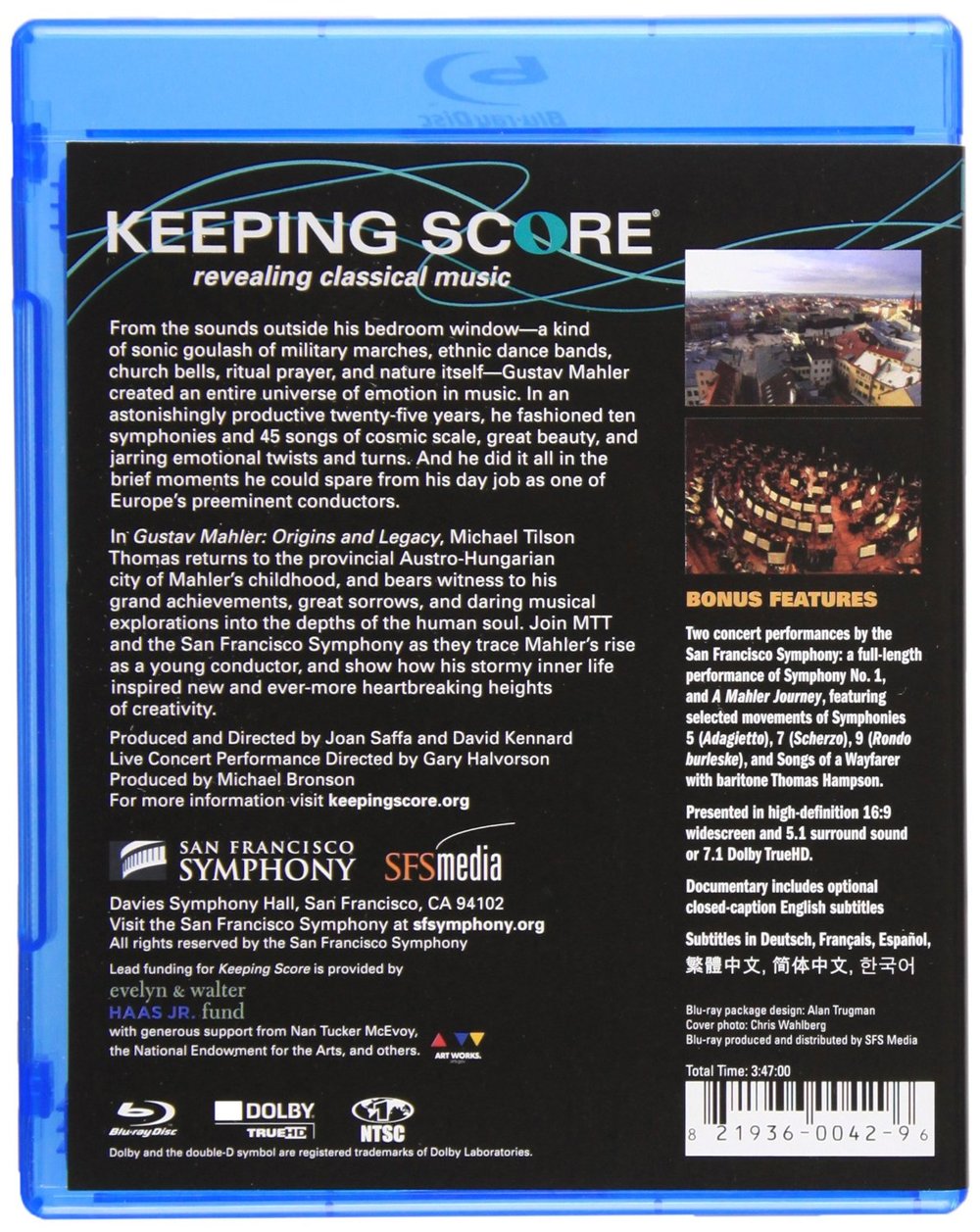

Mahler: Origins and Legacy documentary and concert package, part of the "Keeping Score" series. Michael Tilson Thomas directs the San Francisco Symphony. Directed for TV by Gary Halvorson; Produced by Michael Bronson. This is a two-disc set. Released in 2011, discs have 5.1 surround or 7.1 Dolby TrueHD surround sound. Grade: A for the documentary Origins and Legacy and D for Symphony No. 1
This title consists of three parts. First, here's an executive summary of each part:
1. A documentary, Mahler—Origins and Legacy, with Michael Tilson Thomas as docent. Almost 2 hours long, Origins and Legacy provides rich coverage of the background of Mahler's life and works, especially Symphony No. 1. Contains brilliant HD narrative by Thomas with a vast variety of new images, archive material, and brief clips from San Francisco Symphony recordings of Mahler compositions. Perfect if you already knows something about Mahler's works and wants to pull it all together.
2. Mahler Symphony No. 1 recording. This was doubtless a fine performance, but the video is ruined by a terminal case of DVDitis. The most striking thing about this video is that here is no front-view, whole-orchestra shot in 55 minutes of music!
3. A Mahler Journey. A 55-minute concert with Thomas Hampson singing all of Songs of a Wayfarer (Lieder eines fahrenden Gesellen) followed by excerpts from Mahler Symphonies (other than No. 1). In this film, we do get two short views of the entire San Francisco Symphony from the front—but in both of them the orchestra is at rest. The main value in this concert would be the 4 short Wayfarer songs, which served as preliminary sketches for the writing of Symphony No. 1. (Alert: there are no subtitles for the text of the Wayfarer songs, but the lyrics are easy to find on the Internet.) In this part of the Keeping Score package, we see movements from SFS recordings of Mahler 5, 7, and 9. All the videos seem identical in style to the Mahler Symphony No. 1 recording. No grade for this part of the package.
Let's turn our attention now to the SFS recording of Symphony No. 1. It's hard to believe, but Thomas and Halvorson chop this work up into no less than 890 video clips as you can see in a Wonk Worksheet analysis done in April 2016.
There's 53.5 minutes of music divided into 890 clips for an average of 3.6 seconds per clip. This is like running the mile in 1 minute.
Here's the clip breakdown:
Conductor shots = 217
Conductor-over-backs (C/B) shots =76
Solo and other small-scale clips = 336
*Large-scale clips = 37
*Part-orchestra clips = 9
*Whole-orchestra clips = 0
Instrument-only clips = 207
Other low-value shots = 8 (aggressive pans and dizzy shots)
There are 46 "supershots" (add up the * numbers above of 37+9+0). So the supershots are only 5% of the total clips (46/890). Conductor shots total 293 (217+76), and conductor shots gobble up 33% of the film (293/890).
HDVDarts.com has established the following rules-of-thumb to identify a Blu-ray with DVDitis:
“A good symphony HDVD should have a slow pace with more than 10 seconds per video clip on average. 20 to 40% of the clips should be large-scale "supershots." Conductor shots should be less than 20% of the clips in the video.”
Subject title fails catastrophically on all three tests.
Time for some screenshots. The first shot below is a "dizzy," an aerial view from a camera hoisted above the orchestra on swooping crane. My poor brain, used to seeing the 1st violins on the left, etc. feels like a turned-over fruit basket as I try to figure out who is where. The picture is distorted by a wide-angle lens. Not all the players make it in the view, and some have their backs to the camera. Others might call this the mother of all conductor-over-backs shot. But whatever be the best name, this is the official Thomas/Halvorson whole-band shot for the San Francisco Orchestra:
This next more conventional C/B shot shows how weak the resolution is in this video:
Next we see a decent, if soft, part-orchestra angle:
Off-stage trumpets play early in this piece. Usually I forget this until I see the 3 trumpeters crawling through the orchestra to get back to their chairs. But here, to Halvorson's credit, we see the treble trio actually playing off stage while watching the conductor on a TV monitor:
Next we see 3 large-scale screenshots of whole sections or multi-sections. Halvorson had the ability to make these shots, but only 4% of total clips (37/890) are devoted to these beautiful views:
Halvorson flogs his cameramen to get more and faster clips. The result can be unflattering frames like this one below:
There are many extreme close-up views like the horn player below:
And there are inane split views where you don't get to see either the player or the instrument well:
Next come 2 typical low-quality instrument-only views. These are not isolated instances. There are 207 shots similar to these in the video. And many of them last for only a fraction of a second and remind me of Hong Kong action movies in which the fastest killer gets the girl:
We see this next view below quite often. Is it a poorly-framed instrument-only shot or a poorly-framed small group shot?
There's no doubt that Thomas is the star of this show with 293 shots featuring him, including many of the longer-lasting clips like the one below in which the musicians take on the role of slaves rowing a Roman warship:
This portrait of Thomas is pretty nice, I admit:
But in the next three clips we have a ménage-à-trois of 3 conductor shots in a row (including both regular C shots with at least one C/B view) at 20:03, 20:10, and 20:13. (It gets even worse than this later with a Grand Slam sequence of 4 different regular conductor shots in a row at 26:29, 26:32, 26:51, and 26:56.)
And here at the end is Thomas playing the role of Mahler himself:;
Thomas and Halvorson take the absolute opposite approach to the symphony video than do I.
I want to use the power of HD video to give us conservative, slow, large-scale images glorifying the symphony musicians (working as a team and in solo) in a manner similar to attendance at a live concert. There's no harm is seeing the conductor work, but the videographer should be invisible. Thomas and Halvorson put the orchestra into an atom-smasher. The shards are then reassembled in break-neck fashion to glorify the conductor and the videographer as motion-picture auteurs who deserve as much credit in the product as the composer himself.
Now to a grade. For poor resolution, I deduct 1+ grade; and I deduct 2 grades for the ultimate case of DVDitis, which brings me to D. I could maybe go lower, but I rest with the D out of respect for the enthusiastic performance, decent SQ, and my admiration for the excellent documentary that comes with this package. I give the documentary an A. It’s so sad to see this fine project dragged down by bad video content.


















